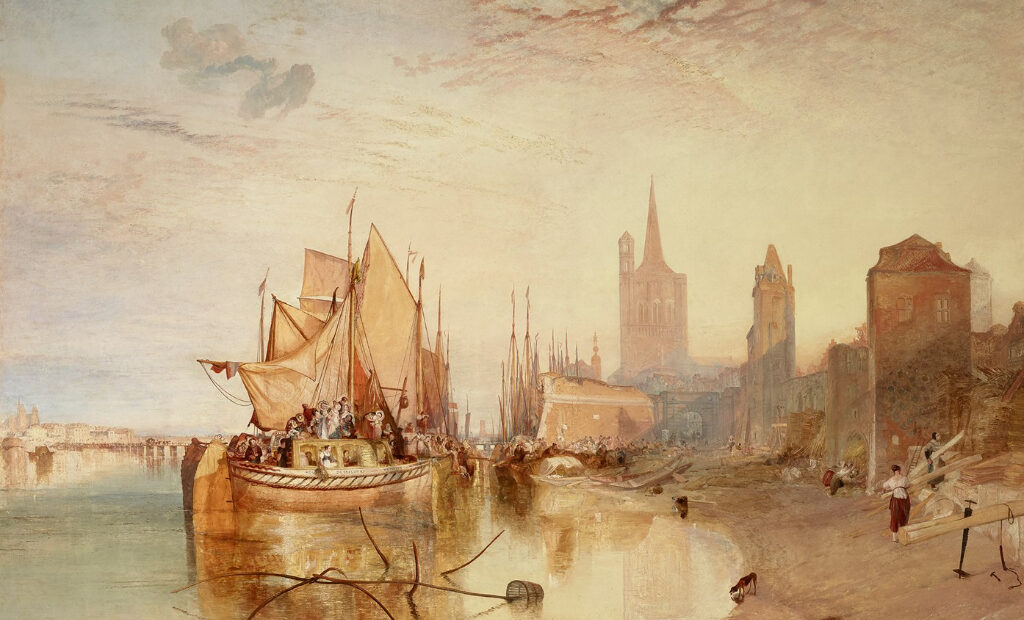Turner on Tour at the National Gallery

Lauded by the Impressionists decades after his passing – his name attached to Britain’s most prestigious contemporary art prize – JMW Turner has long been acclaimed to be the greatest painter to have emerged from these isles. Famously, the pugnacious Londoner bequeathed his life’s work to the nation so as to ensure a place among art history’s pantheon. In 1914, the American industrialist Henry Clay Frick acquired two magnificent Turner river and harbour paintings he produced during the 1820s following his travels around Europe. For almost a century, the monumental canvases have resided in the United States. Now, finally, they have been allowed to return to these shores for a three-month exhibition at the National Gallery.
Harbour of Dieppe: Changement de Domicile (exhibited 1825, subsequently dated 1826) and Cologne, the Arrival of a Packet-Boat (1826) each attest to Turner being drawn towards ports and harbours, whilst also throwing into focus the artist’s admiration for the 17th-century French landscape pioneer, Claude Lorrain. In the early 1820s, the Englishman made two visits to the port of Dieppe before returning across the channel to create the painting of the Normandy location in his London studio. Later that same decade, he would visit the historic German city of Cologne, leading to the second large canvas one finds at the current small but impressive show. Each would be unveiled at the Royal Academy in 1825 and 1826 respectively.
Travelling extensively around Europe, Turner produced sketchbooks of drawings with those rich visual experiences informing his distinctive approach to colour, light and brushstrokes so evident in both the Dieppe and Cologne paintings. Always intended to accompany each other, the imposing works clearly mirror Claude Lorrain’s seaports’ horizontal format, with the Englishman imitating the former’s method of using light to create aerial perspective. At 24, Turner famously exclaimed tearfully, having encountered Lorrain’s Seaport with the Embarkation of the Queen of Sheba, “I shall never be able to paint anything like that picture”, only to create his own port masterpiece, Dido building Carthage in 1815. One of the joys of this exhibition is that the visitor is able to contemplate all of these in close proximity.
Harbour of Dieppe: Changement de Domicile sees Turner depicting a bustling, dynamic centre of trade. For him, ports were restless, cultural melting pots where nature and the man-made came together. A brilliant, haze-inducing afternoon sun provides the entire scene with warmth. Evoked is a fishing community where nothing has changed for centuries, contrasting starkly with the artist’s rapidly industrialising homeland. A seemingly infinite throng of masts soar from merchant vessels laden with goods. Turner has notably layered the reflections created on the water with subtly variegated hues. On the right, some small boats appear so heaped with wine, baskets and paintings as to be close to capsizing. The old city’s elegant 18th-century houses which line the Quai Henri IV are rendered in impressive detail with a thriving outdoor market evident.
Cologne, the Arrival of a Packet-Boat also brings to the fore the English painter’s increasing deployment from the 1820s onwards of transparent luminous effects that would come to defy realism. Set at dusk, it is an altogether more sombre picture. At the beating heart are two large sailed vessels bringing swarms of tourists to the ancient city with its mediaeval walls and vertiginous cathedral. The vibrancy of the revelling visitors contrasts with the handful of labourers, a single dog quenching its thirst at the water’s edge and ruins. Somewhat disturbingly, in the foreground can be seen a peculiar, tentacled form emerging from the water that to modern eyes might be said to resemble a Louise Bourgeois spider, though actually representing rusting fishing equipment.
In these two stunning paintings, one finds an emboldened Turner in his early fifties, starting to bring about the transition in his practice which would ultimately take him to the cusp of abstraction. They also testify to the artist’s thrill at being able to explore the European continent in search of inspiration and ideas following the cessation of the Napoleonic Wars. The rare opportunity this exhibition affords to view these paintings in the UK should be embraced.
James White
Image: The Frick Collection, New York
Turner on Tour is at the National Gallery from 3rd November until 19th February 2023. For further information visit the exhibition’s website here.
























Facebook
Twitter
Instagram
YouTube
RSS